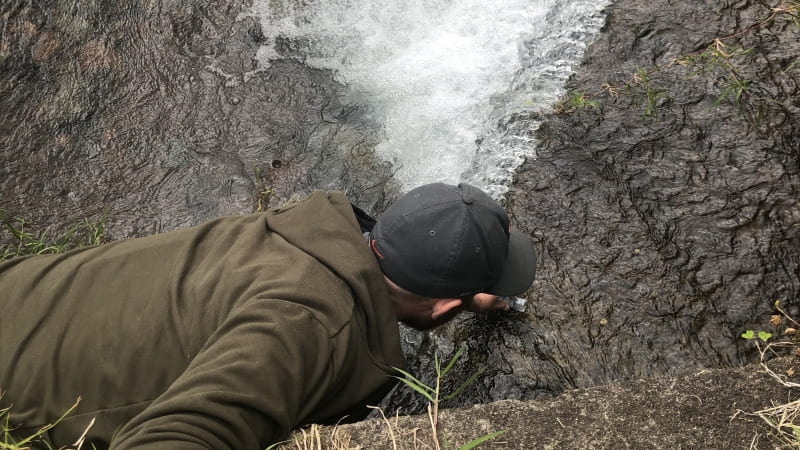BUILDING TOOLKITS WITH BIOLOGY
By: Luyi Cheng

Graduate student Matthew Verosloff, hangs by one arm off a dirt ledge as he leans his body over the edge of a river. His free arm is reaching down with a test tube to collect a sample of water. He’s in Costa Rica escaping the frigid cold of winter in Chicago. It’s sunny, it’s warm, and he’s supposed to be on vacation, but his lab work has somehow followed him the 2,000-mile distance. A Tupperware box of equipment is lying on the ground nearby containing tools for testing water quality.
The water in Cartago, in Costa Rica, isn’t safe to drink, especially consistently over the span of years. There’s too much fluoride in it which can break down teeth and bones. This effect is known as fluorosis. We rarely find the time to worry about this possibility in the United States because our case is the exact opposite: fluoride is added to our tap water, and it’s supposed to improve our dental hygiene. In Cartago, Verosloff is testing the water quality using a biological tool designed in the lab of Julius Lucks at Northwestern University to sense and report contaminants in the water. These tools are aptly named biosensors. They work as a biological reaction contained in a test tube that require just a drop of water to activate. They’re cheap, fast, and easy to use, and the Lucks lab has designed one to test for unsafe amounts of fluoride.
Verosloff adds a drop of water from the river into the test tube. Within an hour, the reaction responds to the fluoride in the water and turns yellow.
The test works.
The innovative ingredient that these reactions use is a biological molecule called RNA. While the four building block molecules of DNA are connected into two separate long strands that pair together like a twisted zipper, RNA is made up of only one of these strands. Instead of the organized and predictable twist that DNA forms, the single strand of RNA has the flexibility to fold into complex tangles of structures that are harder to predict. Some RNA can fold into a structure called a riboswitch: “ribo-” for RNA (which stands for ribonucleic acid) and “-switch” because it can switch a gene on or off. The way the structure folds creates a pocket that is the perfect match for a specific molecule to fit into. The fluoride biosensor uses a riboswitch that fits the shape of a fluoride molecule.
Then there’s the “switch” part.
Biology evolved this riboswitch as a defense mechanism in bacteria. When there’s fluoride in the bacteria, it fits into the riboswitch structure that it matches. Once it fits, the RNA responds by “switching” on a gene. Specifically, it switches on the gene that controls how the bacteria pumps fluoride back out. Two other members of the Lucks lab, Adam Silverman and Walter Thavarajah, have borrowed this RNA from biology and made a minor tweak. Instead of turning on the gene for a fluoride pump, they’ve engineered the fluoride riboswitch to turn on the gene for a yellow color-producing protein. When you see the yellow, the riboswitch has sensed and responded to fluoride.
Developing tools that use riboswitches to apply beyond the lab is exciting progress, but there’s still much left to understand. Beyond the fluoride riboswitch, there are natural riboswitches spread all throughout bacteria. How many of them work, such as how they fold to sense their specific molecules and how they can switch their genes on, is still mysterious in many ways.
Within the familiar walls of the Lucks lab at Northwestern University, in my own research, I attempt to understand the qualities that make a riboswitch work. Their complex structures and how they fold into them can come across as tangled messes, like knotted earphones when you pull them out of your pocket. But as we study them more, we’re realizing they’re nowhere near as chaotic and random as they might initially seem. There’s order to how RNA folds, some type of underlying pattern, that biology has spent millions of years evolving to do exactly what it needs to do. Along the way, the details we learn about how to design RNA-based biosensors are also small puzzle pieces we’re piecing together to unveil the larger picture of how this pattern in biology works. We can learn from this knowledge to try to design better and more versatile RNA biosensors to sense more than just fluoride.
Besides collecting water samples, the Lucks lab usually goes about our day to day activities in a predictable manner. We show up to lab, slip on a pair of gloves, grab a pipette, and start working on the next project. Figuring out how a new riboswitch works? Designing a new biosensor? It all starts with a tube of RNA.
